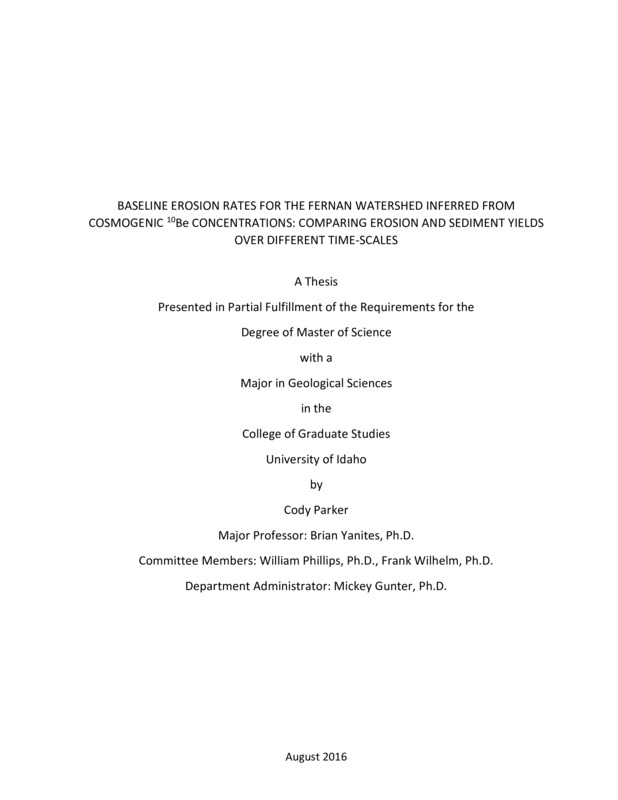Baseline Erosion Rates for the Fernan Watershed: Comparing Erosion and Sediment Yields Over Different Time-Scales
Parker, Cody Luther. (2016). Baseline Erosion Rates for the Fernan Watershed: Comparing Erosion and Sediment Yields Over Different Time-Scales. Theses and Dissertations Collection, University of Idaho Library Digital Collections. https://www.lib.uidaho.edu/digital/etd/items/parker_idaho_0089n_10971.html
- Title:
- Baseline Erosion Rates for the Fernan Watershed: Comparing Erosion and Sediment Yields Over Different Time-Scales
- Author:
- Parker, Cody Luther
- Date:
- 2016
- Keywords:
- Cosmogenic Erosion Sediment Sediment Yield
- Program:
- Geology
- Subject Category:
- Geomorphology
- Abstract:
-
Since the 1990’s, decreased water quality of Fernan Lake has raised concerns about the suitability of the water in the lake for domestic and recreational use. State regulatory agencies have suggested that changes in land use throughout the watershed have increased soil erosion rates and thus sediment yield to the lake, above the baseline rate which may be contributing to the poor water quality. However, the baseline rate of erosion has not been explicitly addressed, and is the focus of this study. I constructed a long-term sediment budget for the upland watershed based on processes integrated over 8-20 ky to test the hypothesis that sediment delivery to the lake has not changed over time, and that changes in land use have not altered erosion rates. Cosmogenic 10Be concentrations in alluvial sediment record erosion rates ranging from ~0.031 +/- 0.002 mm yr-1 to ~0.067 +/- 0.011 mm yr-1 for 6 sub-basins throughout the watershed. The 10Be method integrates erosion rates over 8,000 to 20,000 year time-scales, averaging over short-term variability of erosion due to changes in land use and hydrologic factors. I compared these rates to sediment storage rates inferred from sediment cores taken from the floodplain (spanning ~11,000 years), to estimate the baseline rate of sediment delivery to the lake. Then I compared the baseline sediment yield to modern estimates of suspended sediment yield from sediment load monitoring. Results show that the modern estimate for the 2014-2015 season does not differ significantly from the baseline sediment yield. However, this modern estimate does not take into account sediment transported as bedload, which could increase modern sediment yield estimates by 5-50%, and it is based on data collected during a drought period, indicating that modern yields actually exceed the baseline. In addition, aggrading lower reaches of Fernan Creek indicate an increase in sediment storage, suggesting that modern erosion rates and sediment yields have been enhanced by land use. In addition, I have provided a simple and accessible means for estimating baseline erosion for sub-catchments in Fernan, based on the relationship between baseline erosion and basin-averaged slope, to be used in future studies of erosion in the Fernan Creek watershed.
- Description:
- masters, M.S., Geology -- University of Idaho - College of Graduate Studies, 2016
- Major Professor:
- Yanites, Brian J
- Committee:
- Wilhelm, Frank M; Phillips, William M
- Defense Date:
- 2016
- Identifier:
- Parker_idaho_0089N_10971
- Type:
- Text
- Format Original:
- Format:
- application/pdf
- Rights:
- In Copyright - Educational Use Permitted. For more information, please contact University of Idaho Library Special Collections and Archives Department at libspec@uidaho.edu.
- Standardized Rights:
- http://rightsstatements.org/vocab/InC-EDU/1.0/

